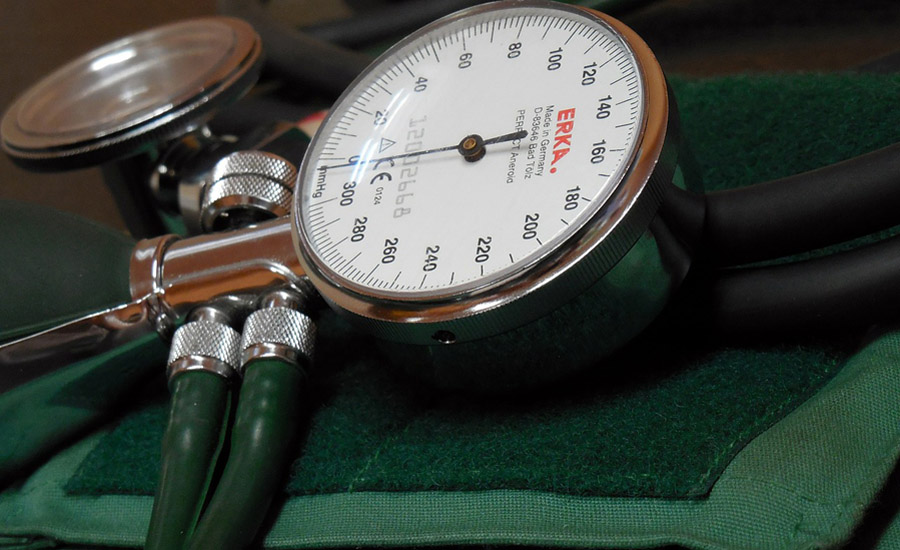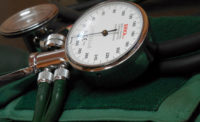Crossing your legs or even talking are among the seven common errors that can lead to inaccurate blood pressure readings, according to the American Heart Association (AHA).
The organization is using May - National High Blood Pressure Education Month – to bring to light these measurement mistakes – all of which can lead to an artificially high reading:
- Having a full bladder – This can add 10-15 points to your reading. You should always empty your bladder before measuring blood pressure.
- Slouching, unsupported back/feet – Poor support when sitting can increase your reading by 6-10points. Make sure you’re in a chair with your back supported and feet flat on the floor or a footstool.
- Unsupported arm – If your arm is hanging by your side or you have to hold it up during a reading, you may see numbers up to 10 points higher than they should be. Position your arm on a chair or counter, so that the measurement cuff is level with your heart.
- Wrapping the cuff over clothing – This common error can add 5-50 points to your reading. Instead, be sure the cuff is placed on a bare arm.
- When the cuff is too small – Your pressure may read 2-10 points higher. Ensure a proper fit. Your healthcare provider can help you with this.
- Sitting with crossed legs – While polite, it could increase a blood pressure reading 2-8 points. It’s best to uncross your legs as well as ensure your feet are supported.
- Talking – Answering questions, talking on the phone, etc. can add 10 points. Stay still and silent to ensure an accurate measurement.
“These simple things can make a difference in whether or not a person is classified as having high blood pressure that requires treatment,” said Michael Hochman, M.D., MPH, Associate Professor of Clinical Medicine at the Keck School of Medicine of USC and a member of the AHA’s Blood Pressure Task Force. “Knowing how to measure blood pressure accurately at home, and recognizing mistakes in the physician’s office, can help you manage your pressure and avoid unnecessary medication changes.”
In clinics, proper measurement may be the exception to practice rather than the norm. At a high blood pressure symposium in Pittsburgh this January, healthcare professionals and clinicians were tested on accurately measuring blood pressure. Of 30 participants, only three passed. “This suggests we must better educate our clinicians and healthcare professionals regarding the proper techniques to accurately measure blood pressure. More accurate blood pressure measurements will empower our clinical teams to aggressively reduce hypertension prevalence and improve overall cardiovascular health in our country,” said Sean Stocker, Ph.D., who chaired the symposium. Stocker is director of Basic and Translational Research at the University of Pittsburgh Hypertension Center and president-elect of the AHA Great Rivers affiliate.
“We need to raise awareness among clinicians about the overall benefit of getting an accurate measurement. If we make a concerted effort to get good measurements, that can lead to correct diagnoses, faster treatment and improving blood pressure control rates,” Hochman said.
Across the country, local experts are tackling their community’s blood pressure problems by encouraging healthcare providers, clinics and health systems to enroll in a national program called Target: BP. The program was created through a collaboration between the AHA and American Medical Association.
Target: BP includes a blood pressure improvement program that starts with helping healthcare providers identify and correct errors in blood pressure measurement. The program also provides guidance for creating a clear treatment plan and partnering with patients to enable ongoing self-management – including teaching them to measure their blood pressure accurately at home.
“Getting an accurate measurement is the first stage in ensuring patients receive the most appropriate care and prevention for heart disease and stroke,” Hochman said. “High blood pressure is a leading cause of cardiovascular disease in the country. If we can get this one health factor under control, there would be a huge impact on reducing strokes and heart disease.”
Additional Resources:
For more information about high blood pressure, visit heart.org/bplevels.








